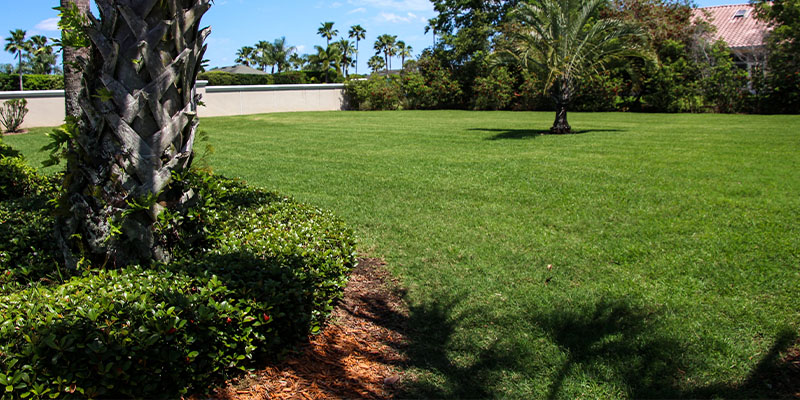Maintaining a healthy and lush lawn is a source of pride for homeowners, but it can be challenging when various pests threaten its vitality – especially if you don’t know or aren’t quite sure what you’re dealing with in the first place. After all, if you can’t confidently identify what’s causing the problem, you won’t be able to effectively treat the source.
So, let’s take the time to explore how to distinguish common lawn pests, such as termites vs. ants, mole crickets vs. roaches, chinch bugs vs. big-eyed bugs, sod webworms and armyworms, fire ants, whiteflies, and grub worms. We’ll also delve into effective methods for identifying and eradicating these pests to preserve your lawn’s beauty and health.
How to Identify and Get Rid of Common Lawn Pests
Let’s begin with a simple example – termites and ants. People often mistake one for another. You may wonder how that’s even possible. Well, ghost ants look very similar to termites. But, these are actually different insects. Termites have straight antennae, a thick waist, and straight wings of equal size. Meanwhile, most ants have elbowed antennae, a narrow waist, and front wings larger than their hind wings (if they even have wings at all).
Common Lawn Pest Confusion
A healthy lawn is a beautiful sight to behold, but it can be easily damaged by pests. Here are some of the most common lawn pests and how you can more easily identify them. After all, it’s not really difficult to get these creatures confused because some of them look a lot alike. However, there are subtle differences that can help you identify which is which.
Mole Crickets vs. Roaches
Mole Crickets: Mole crickets have spade-like front legs for digging, and they harrow irregular tunnels in lawns.
Roaches: Roaches have flattened bodies and are usually nocturnal insects that infest indoors as well.
Chinch Bugs vs. Big-eyed Bugs
Chinch Bugs: Chinch bugs are tiny insects that suck plant sap and cause yellow patches in lawns.
Big-eyed Bugs: Beneficial big-eyed bugs prey on pests like chinch bugs.
Sodworms & Armyworms
Sodworms: Sodworms are larvae of lawn moths and feed on grass blades.
Armyworms: Armyworms are caterpillars that consume grass and move in groups, causing rapid damage.
Fire Ants
Identification: Fire ants are reddish-brown ants that build mound nests and deliver painful stings.
Other ant species can be confused with fire ants. For instance, carpenter ants, pennant ants, and even termites.
Whiteflies vs. Aphids, Mealybugs, and Scale Insects
Identification: Whiteflies are tiny, winged insects that feed on plant sap and cause yellowing of leaves.
Aphids shed their skins, which can be mistaken for whiteflies. However, aphids do not fly away when disturbed. Mealybugs are white and fuzzy, but they don’t fly. Adult whiteflies do fly. Immature whiteflies are also often mistaken for scale insects.
Grub Worms
Identification: Grub worms are beetle larvae that feed on grass roots, leading to dead patches.
Billbugs: These creamy-colored larvae have brown heads and no legs. They can range from a quarter to half an inch long. Meanwhile, cranefly larvae are olive-brown larvae that can grow to be 1 1/2 inches long.
How to Prevent and Get Rid of Common Lawn Pests
A lush, thriving lawn is a homeowner’s pride, but the presence of destructive pests can quickly turn this dream into a nightmare. So, let’s explore proactive measures and targeted solutions to prevent and eliminate destructive lawn pests, including mole crickets, chinch bugs, sod webworms & armyworms, fire ants, whiteflies, and grub worms.
Mole Crickets
Mole crickets are large, brown insects that burrow in the ground. They can damage lawns by feeding on the roots of grass plants. To prevent mole crickets, you can:
- Aerate your lawn regularly to improve drainage.
- Keep your lawn well-watered, as mole crickets prefer dry soil.
- Apply nematodes, which are microscopic parasites that kill mole crickets.
If you have a mole cricket infestation, you can treat it with an insecticide. However, it is important to choose an insecticide product that is labeled for use on mole crickets.
Chinch Bugs
Chinch bugs are small, brown insects that feed on the underside of grass blades. They can cause lawns to turn brown and thin. To prevent chinch bugs, you can:
- Keep your lawn healthy and well-watered.
- Avoid over-fertilizing your lawn, as this can make it more susceptible to chinch bug infestations.
- Apply insecticidal soap or neem oil to your lawn.
If you have a chinch bug infestation, you can treat it with an insecticide. But be careful, because it’s important to choose an insecticide that is specifically labeled for use on chinch bugs.
Sodworms & Armyworms
Sodworms and armyworms are the larvae of moths. They can damage lawns by feeding on the grass blades. To prevent sod webworms and armyworms, you can:
- Dethatch your lawn regularly to remove thatch, which is a layer of dead grass and organic matter that can harbor insect pests.
- Keep your lawn healthy and well-watered.
- Apply milky spore disease, which is a biological control that kills sod webworms and armyworms.
If you have a sodworm or armyworm infestation, you can treat it with an insecticide. But again, it’s important to choose an insecticide that is explicitly labeled for use on sod webworms or armyworms.
Fire Ants
Fire ants are a type of ant that is known for its painful sting. They can be a major nuisance and can also damage lawns by killing grass plants. To prevent fire ants, you can:
- Inspect your yard for fire ant mounds and treat them with an insecticide.
- Keep your yard free of debris, as this can provide fire ants with shelter.
- Plant fire ant-resistant plants in your yard.
If you have a fire ant infestation, you can treat it with an insecticide. And yet again, it is very important to choose a poison that is labeled for use on fire ants.
Whiteflies
Whiteflies are small, white insects that feed on the underside of leaves. They can weaken plants and make them more susceptible to disease. To prevent whiteflies, you can:
-
- Water your plants regularly to discourage whiteflies.
- Plant flowers that attract beneficial insects, such as ladybugs, which prey on whiteflies.
- Use insecticidal soap or neem oil to control whiteflies.
If you have a whitefly infestation, you can treat it with an insecticide. Once more, only use a pesticide that is purposely intended for use on whiteflies.
Grubs
Grubs are the larvae of beetles. They feed on the roots of grass plants and can damage lawns. To prevent grubs, you can:
- Aerate your lawn regularly to improve drainage.
- Keep your lawn well-watered, as grubs prefer dry soil.
- Apply beneficial nematodes, which are microscopic parasites that kill grubs.
If you have a grub infestation, you can treat it with an insecticide. Here yet again, it is really important for you to choose a product that is labeled for use on grubs.
It is important to note that these are just some of the most common lawn pests and their prevention and control methods.
The best way to prevent and control lawn pests is to consult with a professional lawn care company. They can help you identify the pests that are affecting your lawn and develop a treatment plan that is right for you.
Summing All of It Up
A vibrant and healthy lawn can be threatened by various pests, but identifying and managing these intruders is the key to preserving its beauty. Understanding the differences between common pests like termites and ants, mole crickets and roaches, chinch bugs, and big-eyed bugs, sod webworms and armyworms, fire ants, whiteflies, and grub worms empowers homeowners to take targeted action. Whether through preventive practices, natural predators, or targeted treatments, you can ensure your lawn remains a lush and inviting space for your family to enjoy.

